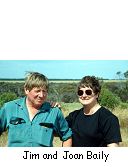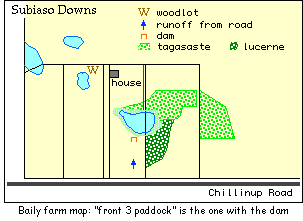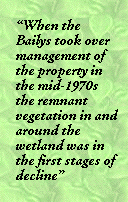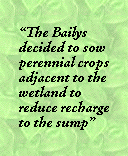
James and Joan Baily, Subasio Downs, Gnowellan

|
Ephemeral wetland protection: Front 3 paddock wetland
James and Joan Baily, Subasio Downs, Gnowellan |


|
 The Site
The Site
Jim and Joan Baily were managers of Subasio Downs from the mid 1970s until the end of 1999. The farm is situated 110 kilometres northeast of Albany in the district of Gnowellan. Eight ephemeral wetlands occur in depressions on the property and they range in size from two to seven hectares. Some are saline and some relatively fresh. There are no defined creeklines and the catchments for each wetland are local. The original vegetation in and around the wetlands was Yate (Eucalyptus occidentalis), paperbark (Melaleuca), pigface (Carpobrotus), chittick (Lambertia), hakea, banksia and some native saltbush (Atriplex). The land was allocated to farming in 1957 and the majority of development occurred between the early 1960s and early 1980s. All eight wetlands have been fenced starting in 1993 with the last one being completed in 1999. The topography is very flat with soils mainly comprising sand over gravel and sandy gravels over clay. One of the wetlands (in 'Front 3 paddock') became the focus of a rehabilitation project during 1994. This 6.5 hectare wetland is the lowest on the property, located at the base of a sand ridge, and is 30 metres below the surrounding landscape.
When the Bailys took over management of the property in the mid-1970s the remnant vegetation in and around the wetland was in the first stages of decline. Fresh water was noticed seeping off the hill on the northern slope adjacent to the wetland. The soak had previously been opened up to stock. Salt water was also noticed seeping into a nearby dam. Waterlogging was a problem and was probably the initial cause of tree and livestock deaths as salinity was not an obvious problem in the mid-1970s. There was a drought in the area in 1969 and the wetland stayed dry until 1978. During the wet year of 1978 the wetland filled up and the water level stayed high for two years; it has only dried out twice since then. During wet years the Bailys noticed severe soil erosion was occurring on the southern side of the wetland. This was due to the run-off from Chillinup Road and the contour banks not working as well as they could. The dam had also been sited poorly and it should have been constructed mid-slope rather than lower slope. Stock were moving through the wetlands and eating out all the lower vegetation. Salinity was noticed for the first time on the property in the early 1980s. The Solution In January 1992 eight piezometers were installed across the wetland to measure and monitor the depth to ground water. During 1994 a 3.5 kilometre solar powered electric fence (two power/two earth wires) was erected around the swamp. The Bailys decided to sow perennial crops adjacent to the wetland to reduce recharge to the sump and a total of 40 hectares was seeded to tagasaste on the northwestern facing slope during 1994. The tagasaste planting was done on a keyline system and the spacing of rows at the site were ten metres apart to allow for the passage of machinery and mustering of stock. Other reasons for planting tagasaste adjacent to the wetland were to:
During 1997 20 hectares of mixed lucerne was seeded on the southeastern side of the wetland using a K Hart Seeder. From 1994 to 1997 mixed eucalypt species were planted on the contour bank adjacent to the wetland for aesthetic purposes. Just prior to planting the ground was prepared by ripping and spraying "Roundup" and "Simazine" to control weeds. 30 hectares on the southeastern facing slopes were planted with bare rooted seedlings using a tree planter during 1997. Subsequently sheep went through the fence during a fierce electrical storm and the area had to be replanted. During establishment of the trees, rabbits were a problem. They were baited using 1080 poisoned oats and are not such a big problem now. Insect pests included red mite, spring beetle and grasshoppers. Kangaroos were also suspected of pulling out some plants. Establishment and management costs
The Bailys believe that fencing and revegetation is a necessary part of a farm plan. They were keen to get areas of remnant vegetation fenced so that they didn't deteriorate any further. They have now fenced all eight wetlands on the property using a total of 20 kilometres of materials. The regeneration response of the native vegetation has been different for each wetland and they noticed that it also varied with the seasons. Regeneration usually appeared two years after fencing and was occurring on the higher areas first. They also suspect that the ground water recharge has been reduced based on the piezometer readings. There was also natural regeneration of the paperbarks and yates in places, though it is noticeable that the process is slow, possibly due to the salt being so close to the edges of the regeneration. With the establishment of tagasaste the potential stocking rate for cattle is 1.5 to 2 animals per hectare with a weight gain of around one kilogram/head/day. The Bailys believe that the success of the conservation works they have done on the property and the long-term success of the farm overall will depend on further management practices taking effect. More planting of tagasaste and lucerne is required and they hope eventually to re-site the dam that is currently adjacent to the wetland to a position further upslope. The contour banks also need to be altered to re-route the water away from the wetland. Farm statistics
Wetland Catchment Statistics
Map Reference: 1:50 000 2629 II and 2529 II, Plantagenet Locations 6209, 6214, 6215 and 6223 |
|||||||||||||||||||||||||||||||||||||||
 |
||||||||||||||||||||||||||||||||||||||||
 |
||||||||||||||||||||||||||||||||||||||||